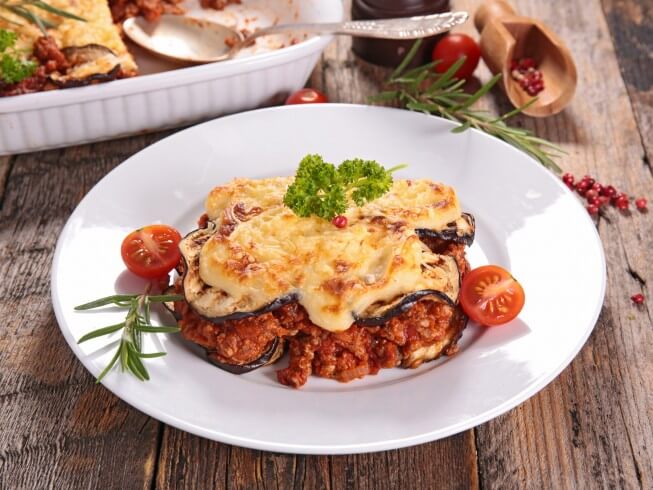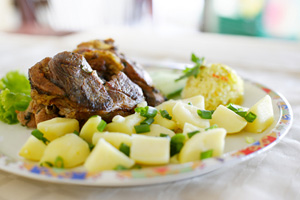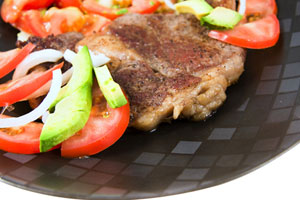Delicious recipes for red velvet cakes, cupcakes, and cheesecakes.

This eggplant Moussaka makes low-carb a cinch. Baked eggplant is layered with cheese and ground beef and topped with a creamy sauce.

4 long, narrow eggplants
1 cup chopped onion
1 1/2 pound lean ground beef or ground lamb
1 1/2 tablespoon olive oil, plus extra for greasing
1/4 teaspoon salt
black pepper, to taste
1/8 teaspoon ground nutmeg
1/4 teaspoon ground cinnamon
1/2 teaspoon sugar substitute
1 can (8 ounce size) tomato sauce
1 tablespoon butter
1/4 pound freshly grated Parmesan or Romano cheese
6 large eggs
1/2 cup heavy cream
2 tablespoons melted butter
Peel the eggplant, then slice it into 1/4-inch thick slices lengthwise. Sprinkle each slice with salt and place them in a colander in the sink (or over a plate) to drain for 30 minutes.
Rinse the eggplant slices then place them between sheets of paper toweling, pressing down lightly, to dry.
Preheat the oven to 350 degrees F. Grease a 9x13-inch baking dish and rimmed baking sheet.
Place the eggplant slices on the baking sheet. Brush with olive oil. Place the baking sheet in the oven and bake at 350 degrees F for 10-15 minutes, or until the eggplant is tender. Remove from the oven and set the eggplant aside.
In a large skillet, combine the onion, ground meat, and olive oil. Cook, stirring frequently, until the meat is browned and the onion is soft.
Add the salt, pepper, nutmeg, cinnamon, sugar substitute, tomato sauce, and butter. Cook, stirring frequently, until the sauce has reduced and is very thick. Remove the pan from the heat and set aside.
Place half of the eggplant slices in a layer in the bottom of the greased baking dish. Top with 1/3 of the grated cheese. Spread half of the meat mixture over the cheese. Add another 1/3 of the cheese and the remaining meat. Place the remaining eggplant slices in a layer over the meat. Top with the remaining cheese.
Beat together the eggs and cream until completely mixed. Evenly pour the mixture over the moussaka, completely covering the cheese layer. Drizzle the melted butter over the top.
Place the baking dish in the oven and bake at 350 degrees F for 50-60 minutes, or until golden brown and a knife inserted in the center comes out mostly dry.
Remove the pan from the oven and let cool for 10 minutes, then cut into serving pieces. Serve warm.
Use a mandoline to slice the eggplant evenly.
Try different spices, like allspice or paprika, to vary the flavor.
Let the moussaka rest for a while after baking to allow the layers to set further for better slices.
Layering the eggplant, meat, and cheese in a pattern can create a visually appealing presentation.
Check for doneness by inserting a knife; it should come out mostly dry.
Store leftover baked moussaka in individual portions for easier reheating and serving.
For a lighter version, reduce the amount of cheese or use a lower-fat cheese option (note that the carb count may change using lower-fat alternatives).
Feel free to add other vegetables, like bell peppers or zucchini, to the meat sauce for added flavor.
Moussaka is a layered baked dish, traditionally made with eggplant, ground meat, and a creamy sauce, originating from Mediterranean cuisine, particularly popular in countries like Greece.
Salting the eggplant helps to draw out excess moisture, which can make the dish watery, and it also removes some of the bitterness often found in eggplants, resulting in a better flavor and texture.
Yes, zucchini can be used as a substitute for eggplant if you're looking for a different flavor or if you prefer not to use eggplant; however, it will change the texture of the dish.
Lean ground beef or ground lamb is traditionally used, but you can also substitute with ground turkey or chicken for a lighter version. Each will have a slightly different flavor.
Peeling is optional. The skin can add texture, but many people choose to peel it for a creamier dish. If using smaller eggplants, the skins can often be more tender.
Draining the salted eggplant is crucial to remove excess moisture and bitterness, which can lead to a soggy final dish.
Moussaka can be prepared a day in advance, assembled, and stored in the refrigerator. Just bake it before serving.
Leftovers can be stored in an airtight container in the refrigerator for up to 3-4 days.
Yes, it freezes well. Wrap it tightly in plastic wrap and aluminum foil or place it in a freezer-safe container. It can be frozen for up to 3 months. Thaw in the refrigerator before reheating.
Reheat individual pieces in the microwave, or place the entire dish back in the oven at 350 degrees F until heated through. Cover the dish with foil to keep moisture in while reheating.
If the sauce is too watery, let it simmer longer during cooking to reduce the liquid further, providing a thicker final consistency before assembling.
While Parmesan or Romano are traditional, you can use any cheese that melts well, such as mozzarella or cheddar.
Substitute the ground meat with lentils, mushrooms, or a meat substitute. Also, make sure the cheese and cream are vegetarian-friendly.
Allow the moussaka to cool for about 10 minutes after baking to firm up, making it easier to cut and serve clean slices.
9x13-Inch Baking Dish: For layering the eggplant, meat mixture, and cheese, and for baking the moussaka in the oven.
Rimmed Baking Sheet: Used to bake the eggplant slices. The rim helps contain any oil or moisture released during the baking process.
Colander: For draining the salted eggplant slices for 30 minutes.
Measuring Cups and Spoons: For measuring ingredients such as the onion, nutmeg, cinnamon, and cream.
Large Skillet: Used for cooking the onion and ground meat mixture.
Spatula or Wooden Spoon: For stirring the meat mixture in the skillet and combining ingredients.
Knife: For peeling and slicing the eggplant into 1/4-inch thick slices and chopping the onion.
Cutting Board: A surface for preparing the eggplant and chopping any other ingredients such as onion.
Paper Towels: Used for drying the rinsed eggplant slices after draining, helping to remove excess moisture.
Mixing Bowl: For combining the eggs and heavy cream before pouring over the moussaka.
Whisk or Fork: For beating the eggs and cream together until well mixed.
Cooling Rack: Optional, but can be used after baking to allow the moussaka to cool a bit before serving which helps it hold its shape better when sliced.
Large Knife: For cutting the finished moussaka into serving pieces after it has cooled.
Tzatziki Sauce: A cool and creamy tzatziki made with yogurt, cucumber, and garlic adds a refreshing contrast to the warm, rich flavors of the moussaka.
Greek Salad: A simple Greek salad with tomatoes, cucumbers, olives, and feta provides a crunchy and vibrant side that balances the moussaka's hearty texture and richness.
Hummus: A smooth, garlicky hummus serves as a delightful dip for fresh vegetable sticks or pita bread.
Roasted Veggies: A medley of roasted seasonal vegetables, like bell peppers and zucchini, complements the moussaka's ingredients and adds an extra dose of color and nutrients to the plate.
Mediterranean Quinoa: This protein-packed side dish, tossed with herbs, lemon, and diced vegetables, brings a nutty flavor that works well alongside the layered eggplant.
Toasted Pine Nut: Toasted pine nuts sprinkled over the moussaka or as a topping for side salads introduce a crunch that contrasts with the creaminess of the dish.
Feta Cheese Crumbles: A sprinkle of crumbled feta on top of each serving adds a tangy, salty punch that pairs nicely with the creamy cheese in the moussaka.
Chickpea Salad: A simple chickpea salad mixed with herbs, lemon, and olive oil mirrors the Mediterranean roots of the moussaka while adding texture and protein.
Sauteed Spinach: A side of sauteed garlic spinach is a healthy complement that introduces some bitterness, which offsets the creamy, rich elements of the dish.
Zaatar Pita Chips: Crunchy pita chips sprinkled with zaatar can provide a tasty snack or side that echoes the herbs used in the moussaka.
Wine Pairings
Malbec: This wine brings a hearty personality to match the richness of the moussaka. Look for one with dark fruit flavors like blackberry and plum, along with a touch of spice that can complement the cinnamon and nutmeg in your dish.
Chardonnay: An oaked Chardonnay with ts buttery finish and hints of vanilla will pair beautifully with the creaminess of your creamy bechamel sauce.
Sangiovese: With its bright acidity and cherry flavors, Sangiovese can bring a refreshing contrast to the savory layers of eggplant and meat.
Other Alcohol Pairings
Cabernet Sauvignon: A well-structured cab with bold tannins can handle the robust flavors of the beef and spices. Look for one with rich berry notes and just a hint of oak.
Dry Vermouth: If you want something a little different, consider a dry vermouth on the rocks with a twist of lemon. Its herbal character can add an intriguing layer to the meal without overshadowing the flavors.
Gin & Tonic: A classic gin and tonic, especially with a citrus-forward gin, can provide a refreshing contrast.
Non-Alcoholic Pairings
Sparkling Water with Lime: The fizz and zesty lime can cleanse the palate between bites of the rich moussaka.
Herbal Iced Tea: Go for a chamomile or mint herbal tea, which can offer a relaxed, fragrant complement to the warming spices in the dish without competing for attention.
Soda Water with Pomegranate Juice: This sparkling combo brings a refreshing twist. The pomegranate adds a touch of sweetness that pairs nicely with the savory aspects of the moussaka.
Delicious recipes for red velvet cakes, cupcakes, and cheesecakes.
Beer makes batters better, meat more tender, and sauces more flavorful.
Make your mornings a little less hectic with these overnight breakfast recipes. Prep the night before and enjoy a warm, comforting meal in the morning.



Online since 1995, CDKitchen has grown into a large collection of delicious recipes created by home cooks and professional chefs from around the world. We are all about tasty treats, good eats, and fun food. Join our community of 200K+ members - browse for a recipe, submit your own, add a review, or upload a recipe photo.

reviews & comments
August 9, 2017
Made this for the first time ever. Amazing. If you have never had egg plant, think of tasting and texture similar to roasted portabella mushrooms. I made my own tomatoem sauce, so it was not as saucy as the photo. Also, used shredded white cheddar with parm.
August 30, 2012
I love this recipe! Don't miss the potatoes at all. Great low carb dish. Note: Make sure you slice the eggplant as thin as specified (but no thinner); the first time I tried this I sliced closer to 1/2 inch and almost stacked the layers higher than the pan.
December 17, 2011
came great the first time - and i had never cooked moussaka before! hoping it wasn't beginner's luck :)
May 18, 2011
Love this recipe for moussaka! One of my favorites and being on atkins this is perfect and filling! Kids love it too! Making again tomorrow for family coming to town ..Greek family!